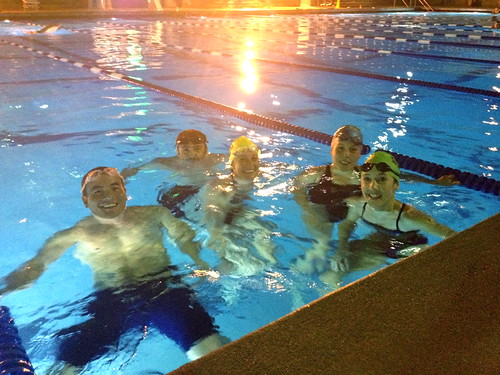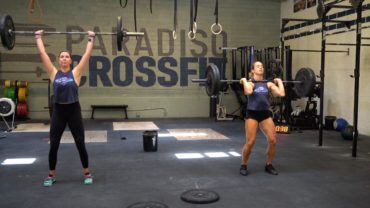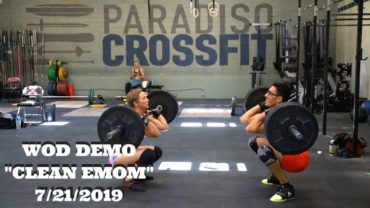What’s your SWOLF Score?
Friday, September 21, 2012
Warmup:
DROM
Skill practice:
Gymnastics warm-up
15 minutes of 3 rounds of:
3 Tuck or straddle press to headstand
6 Pistols
8 Butterfly pull-ups
10 Hip-back extensions
Workout:
7 Push press (185/120)
14 Lateral box jumps (24/20)
21 Toes to bar
7 Push jerks (185/120)
14 Lateral box jumps
21 Toes to bar
7 Split jerks (185/120)
14 Lateral Box jumps
21 Toes to bar
Notes: Lateral box jumps should be performed with both feet touching top of the box. Conditioning Bias may sub situps or V-ups for Toes to bar.
Cool Down:
Cobra, 1 min
Cat stretch, 1 min
Calf stretch, 30 sec per side
Pike/Plow, 1 minutes
Last night was the first Swim Night for PCF and another huge step for our developing Endurance program. We now have a lane reserved every Thursday night from 7:30-8:30pm at the Culver City Plunge. You don’t need to pay to enter the pool, just tell the front desk you are there for Crossfit. Try to show up ten or fifteen minutes early so you can perform DROM and shoulder mobility on deck to get as much pool time as possible. I’ll be there ready with bands and foam rollers to help you out. The class will be similar to Track Night and regular Crossfit classes: Warmup, Skill Work (see below), WOD, and then a Cool Down that will probably include some kicking and/or pulling. Swimming can be monotonous and boring at times, but last night reminded me how much easier and more fun it is when you do it with your teammates! If you have any questions about attending please drop a comment below!
Coaching last night also reminded me how incredibly technical this sport is. Some people glide through the water with ease and grace, while others splash violently trying to stay afloat. As with all human movement, a major component of your athletic ability is determined by your efficiency, whether it be swimming, running, or the Olympic lifts. But I believe, and I hope this post will show, that efficiency is more important in swimming than in any other sport. Put another way, improvements to technique alone will translate to greater gains in swimming than in any other sport. This is how many master swimmers are still able to set lifetime PR’s well into their 40’s and 50’s. What follows naturally then is a skill based approach to swimming in place of the traditional emphasis on volume.
SWOLF Score = Strokes per lap + Time (in seconds) per lap
Velocity = Stroke Length (SL) x Stroke Rate (SR)
This is demonstrated by your SWOLF score, also known as your swimming GOLF score. To get your score, add the total number of strokes (counting both arms) to do one lap to the total amount of time (in seconds) it takes to complete the lap. For example, 15 strokes and 15 seconds to complete one lap would equal a SWOLF score of 30. The goal is to get this number as low as possible. There are three different ways to do this: 1) Less strokes / Same time. In our example, 13 strokes in 15 seconds, a score of 28. This covers the distance in the same amount of time but with fewer strokes, meaning you are being more efficient per stroke and have a greater stroke length. This is a good thing if you are doing a long open water swim and value efficiency over speed. 2) Same strokes / Less time. Example, 15 strokes in 13 seconds, also a score of 28. Without increasing stroke length or efficiency, the total time is reduced by increasing the stroke rate and therefore your total power output. This can be a good thing if you are in a high school swim meet trying to lower your time, but comes at a much higher energy cost. And finally, 3) Less strokes / Less time. 13 strokes in 13 seconds, a score of 26! You increase stroke efficiency and your total power output at the same time. Your stroke length and stroke rate increase simultaneously. This is ideal and what all swimmers should strive for!
Technique and efficiency are developed through practice, while strength and power are developed through training. The SWOLF score shows that optimal swimming is a balance between efficiency (stroke length) and power (stroke rate). But so what? That formula has the same application for all movement and still doesn’t prove why technique is more important in swimming than other sports. What makes swimming unique? The answer is that water is completely different than air. It is very thick and causes a lot of drag. Increasing your speed in water comes at an exponential increase in energy expenditure, while reducing drag is simply a matter of practice and improved technique. That is why you will often hear a swim meet referred to as a contest to see who can slow themselves down the least.
Terry Laughlin, founder of Total Immersion swimming, explains this better than I ever could in the Crossfit Journal article Why Swimming Is Different, “Here’s why: The world records for the mile run and the 400-meter swim are virtually identical. If you were to run once around the track with Alan Webb, America’s best miler, he’d beat you easily, but—even if you’re purely a recreational jogger—by running easily and efficiently, you could nearly match the number of strides he took to cover 400 meters. If, on the other hand, you tried to swim 100 meters with American record holder Klete Keller, not only would he beat you easily but—assuming you could complete 100 meters—the difference between his stroke count and yours would be staggering. Keller and other elite freestylers can easily swim 25 yards in 7 or 8 strokes (counting each hand entry as one stroke), while novice swimmers typically average 20 to 25 strokes for the same distance.
And that threefold difference in stroke efficiency is only half the story. A worldclass runner is about 90% mechanically efficient, meaning that 90 of every 100 calories expended produce forward motion, while approximately 10 are lost to muscle heat, ground friction, wind resistance, etc. Because water is 900 times thicker than air and highly unstable as a medium for applying power, a world-class swimmer is only 9% mechanically efficient—which means the typical novice swimmer achieves energy efficiency of perhaps 3%. Thus, the path to swimming improvement is not to make more energy available through training; it’s to waste less energy by improving your stroke. If you can increase your mechanical efficiency even modestly— from, say, 3% to 4%—that will translate into a 33% improvement in your swimming capacity. No workout program can produce those kinds of results, but I’ve routinely seen swimmers in Total Immersion workshops achieve that sort of gain in a single weekend.”
Whether you are a crossfitter trying to be as fit as possible, or a triathlete training for your next race, I hope you have gained some insight into the application of developing technique, regardless of the movement. I am dedicated to helping every athlete in the gym develop greater efficiency in running, swimming, and Crossfit so they can maximize their athletic potential and realize any goals they set for themselves. If you have any questions, feel free to email me or ask me anytime in the gym. I’ll be more than happy to point you to great resources and review drills to set you on the right path. I am so pumped for swim night and can’t wait to delve deeper into this unique and complicated skill with experienced and novice swimmers alike! (If you’ve made it this far in the post, thanks for sticking around! I’m sorry if it’s been a little repetitive or slightly confusing. As always, happy training!)
Additional Resources: A must for anyone interested in efficient swimming
Why Swimming is Different by Terry Laughlin. (PDF)
Kaizen Swimming by Terry Laughlin. (PDF)
Swim Posture (wmv, mov) with Coach Michael Collins. (12 min video. A great overview of efficient swimming)
















